Composition comprising bacteriophages for reducing, eliminating and/or preventing Salmonella enteritidis, Salmonella typhimurium and Salmonella paratyphi B
a technology of bacteriophages and a new cocktail, applied in the field of new cocktail of bacteriophages, can solve the problems of imposing a considerable economic burden on many countries, affecting the health of people, and affecting the health of people, and achieve the effect of preventing the colonization of strains
- Summary
- Abstract
- Description
- Claims
- Application Information
AI Technical Summary
Benefits of technology
Problems solved by technology
Method used
Image
Examples
example 1
ization by Genome Size
[0059]The size of the genome of the phages is determined by pulsed-field gel electrophoresis (PFGE), based on the protocol of Evergreen Phage Lab (Olympia, Wash.) from 2009. The phages were taken at a concentration of 109 pfu / ml. Then agarose plugs were prepared, which contained 400 μl of the suspension of the phage and 400 μl of agarose at 1% (w / v) (Ultra Pure DNA Grade Agarose: BioRad #162-0137) in 0.5% of TBE buffer. After lysis with proteinase K (Promega), at a final concentration of 0.1 mg / ml, washings with lysis buffer were carried out. The PFGE run conditions were as follows: 6 volts, 15 h, 2 s initial switch time and 10 s final switch time. The gel was stained with gelRed (Biotium) 3× and was visualized in the GelDoc System (BioRad).
[0060]According to PFGE of the 6 phages of the invention, φSan13 (SEQ ID NO: 1), φSan14 (SEQ ID NO: 2), φSan15 (SEQ ID NO: 3), φSan23 (SEQ ID NOs: 4 and 5), φSan24 (SEQ ID NO: 5) and φSan25 (SEQ ID NO: 7), the genome size wa...
example 2
ion Electron Microscopy
[0061]The pure phages at a concentration of 1010-1011 pfu / ml were placed on a grid covered with carbon of electrons and negative staining was performed with 1% of phosphotungstic acid. After drying, the preparations were examined with the transmission electron microscope (TEM). The morphology of the phages and their dimensions were recorded.
[0062]The phages φSan15 (SEQ ID NO: 3), φSan23 (SEQ ID NOs: 4 and 5), φSan24 (SEQ ID NO: 6) and φSan25 (SEQ ID NO: 7), which form part of this invention, belong morphologically to the family Myoviridae of the order Caudovirales (FIG. 2). The electron micrographs show that the phages have icosahedral heads with dimensions between 50 and 70 nm, with long contractile tails, with a length between 120 and 180 nm.
example 3
y of the Cocktail of Bacteriophages in Bacterial Reduction
[0063]A culture of Salmonella enteritidis (OD600=0.01) was infected with a cocktail of phages, described in this invention. A multiplicity of infection (MOI) of 0.1 was used. The culture was incubated with stirring at 37° C. for 15 h. The absorbance of the culture and the bacterial count were monitored by plating serial dilutions.
[0064]Reductions of Salmonella enteritidis of 3.12; 4.3; 3.86 and 4.29 log 10 CFU / m were obtained, among other things, after infection with the individual phages of the collection and a maximum of 4.62 log 10 CFU / ml with the cocktail of phages (FIG. 3; the culture of the bacterium without the cocktail of phages is shown in blue, and the culture of the same bacterium with the cocktail of phages is shown in red).
[0065]The combined activity of a minimum of 3 phages in the cocktail allows a greater reduction of Salmonella relative to the individual phages. The fact that the individual phages show lower e...
PUM
| Property | Measurement | Unit |
|---|---|---|
| temperature | aaaaa | aaaaa |
| temperature | aaaaa | aaaaa |
| pH | aaaaa | aaaaa |
Abstract
Description
Claims
Application Information
 Login to View More
Login to View More - R&D
- Intellectual Property
- Life Sciences
- Materials
- Tech Scout
- Unparalleled Data Quality
- Higher Quality Content
- 60% Fewer Hallucinations
Browse by: Latest US Patents, China's latest patents, Technical Efficacy Thesaurus, Application Domain, Technology Topic, Popular Technical Reports.
© 2025 PatSnap. All rights reserved.Legal|Privacy policy|Modern Slavery Act Transparency Statement|Sitemap|About US| Contact US: help@patsnap.com


